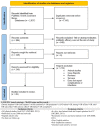Efficacy and safety of using antibiotics to prevent post-operative complications in oral implant treatment: evidence-based review
- PMID: 37907456
- PMCID: PMC10618562
- DOI: 10.1038/s41405-023-00174-4
Efficacy and safety of using antibiotics to prevent post-operative complications in oral implant treatment: evidence-based review
Abstract
Aims: To identify and critically appraise available evidence on the efficacy and safety of antibiotics in preventing complications following oral implant placement treatment.
Methods: An electronic search was performed using PubMed, Ovid MEDLINE and Cochrane Library databases up to July/21 for the purpose of answering the research question: In[healthy adults treated with dental implants]the use of[different antibiotics before or immediately after treatment]in comparison to[treatment without antibiotics]is safe and effective in terms of[infection, pain, swelling, wound dehiscence, soft tissue healing, early/late implant failure]? Following the Best Evidence Topic methodology, the included studies were categorised based on the Oxford Centre for Evidence-Based Medicine (OCEBM) ratings. The critical appraisal skills programme CASP checklist was used for the methodological analysis. The risk of bias assessment was performed according to the Cochrane Methodology for Systematic Reviews of Interventions.
Results: 26 of the 245 initially identified articles met our inclusion criteria for analysis after applying rigorous filters. The included human studies demonstrated significant methodological heterogeneity, precluding meta-analysis. These studies spanned evidence levels II to IV, as per OCEBM 2011 classifications, with the United States contributing the most studies (19.2%, n = 5), all at level III. The United Kingdom and Spain followed with three studies each (11.5% each), two from the UK and one from Spain classified at level II. Most studies had less than 1 year of follow-up (21%). Our analysis included 26 studies, with 38 antibiotic patient groups totalling 7459 patients. Amoxicillin was the predominant antibiotic, with various dosage regimens. Complications were observed in studies across different amoxicillin regimens at a cumulative incidence of 5%.
Conclusion: The evidence on antibiotics to prevent implant failure presents uncertain and heterogeneous findings. High-risk bias and underpowered studies were prevalent. Future research should prioritise multicentre, double-blinded RCTs with larger samples and longer follow-ups. Structured methodologies, antibiotic stewardship, and adherence to guidelines are needed. Amoxicillin (2 g) was commonly prescribed, but guidelines recommend 3 g, which results in relatively low complications yet there is limited evidence to support it. Clindamycin was favoured for penicillin allergies, but caution is advised due to potential implant failure risk. Consistent use of antiseptic mouthwash was observed. Future research should explore alternatives to antibiotics and antibiotic stewardship. Establishing a well-funded research consortium could yield conclusive results for clinical practice.
© 2023. The Author(s).
Conflict of interest statement
The authors declare no competing interests.
Figures





References
-
- Dental Implants Market Size, Share & Growth Report, 2030. https://www.grandviewresearch.com/industry-analysis/dental-implants-market.
-
- Europe Dental Implants Market Size | Forecast Report - 2032. https://www.sphericalinsights.com/reports/europe-dental-implants-market.
Publication types
LinkOut - more resources
Full Text Sources
Miscellaneous

